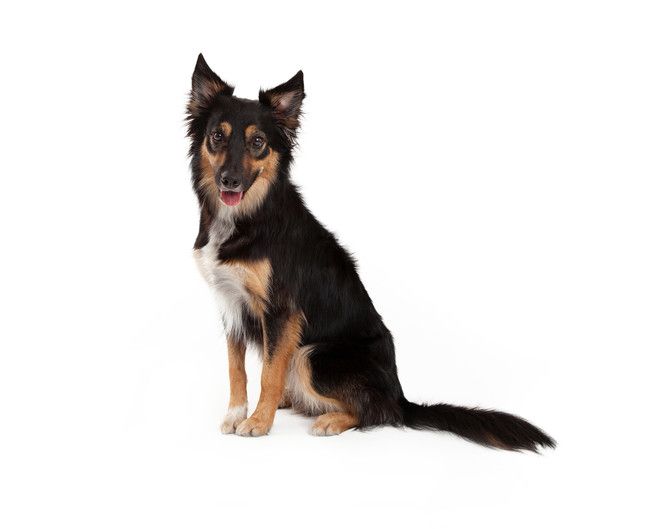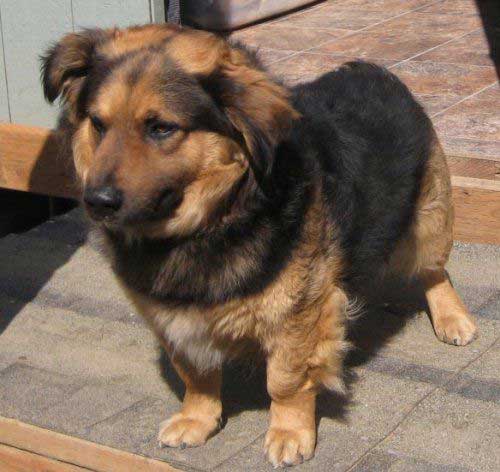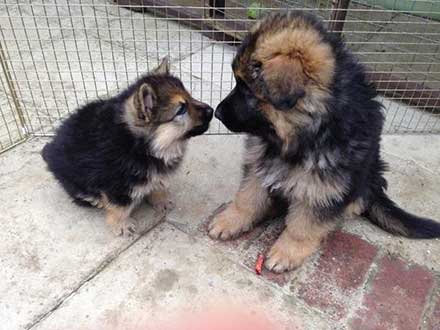The desire for designer dogs is continually shifting in focus, from expensive pure bred pups in unusual colors to interesting cross-breeds that blend physical traits and personality quirks to create a family-friendly pet.
While some help to support the idea that hybrid/mongrel dogs are a great alternative to over-bred breeds, there are other occasions where designer trends can be damaging.
One prime example of this is with the concept of the miniature German shepherd. These dogs can sound like a brilliant idea on paper, but the reality is much different. In fact, these dogs technically don’t exist.
In this guide to the myths and realities surrounding mini German shepherds, we will look at the reason for the hype surrounding these dogs, the real reason why you may see some smaller German shepherd dogs around, the potential pros and cons of opting for one of these animals and options for buying/adopting them.
It is easy for hopeful owners to be drawn into the fantasy of owning a mini GSD, especially with some of the sales techniques online, but there is a lot to consider when buying one and the dog you get may not be the dog that you expect.
Table of Contents
Why is the mini German shepherd such an attractive prospect for families compared to a regular GSD?
German shepherds can be attractive to families for a number of reasons – they are smart dogs with a loyal streak and are known to become playing, loving member of the family if they are trained correctly.
The problem that often puts buyers off, however, is the size. There are always concerns that these large dogs will be difficult to own with children in the house – even though they are pretty good-natured that way – and that there simply wont be enough room for them.
A GSD needs space to run around and play in, which makes apartment living out of the question.
The idea of having a mini version of a German shepherd is therefore appealing to apartment dwellers that love the breed but do not have the space to own a full sized one.
This leads to fantasies of tiny shepherds living contently in the home, acting like a cuter smaller version of an old family pet. The problem is that the reality is vastly different.
Beware of people that say that they have teacup German shepherd puppies: they haven’t.
The additional problem that hopeful owners have to face is that there are a number of breeders, or a least online sellers, trying to get away with saying that they have a genuine teacup German shepherd for sale.
Teacup is one of those buzzwords with designer animals that has unfortunately lingered in the public consciousness.
Whenever an animal has been bred to be ridiculously small and suitable for the home – such as with the teacup pigs that were a massive craze many years ago – they are given this name to make them sound even smaller and cuter.
Perhaps there will be an accompanying photo of an animal in a cup and saucer to really hammer the point home.
Beware of anyone trying to pull this stunt because GSDs cannot get that small and they are just trying to ramp up their miniature German shepherd price.
Take a second look at those photos on those websites, do they really look like a pure mini German shepherd dog?
There are always going to be people that counter this argument by saying “my German shepherd is small and miniature, check out my cute photos”.
What viewers, and perhaps prospective buyers are then faced with is a picture of a young dog next to its mother, a puppy that is only going to be “teacup” sized for another week or a dog that clearly has traits of another breed.
If you know your dog breeds, you will know that there are certain characteristics to look for an a purebred GSD – such as the back line, the shape of the legs, the size of the muzzle and those pointed ears. A big fluffy coat, long bushy tail, floppy ears or a squashed in face are big red flags that another breed is in the mix.
The truth is that “real”, pure bred miniature German shepherds do not exist.
So if it isn’t a purebred, what are these small German shepherds?
There are three reasons why the dog you are being shown is a small looking GSD: it could be an undersized runt of the litter, an animal with dwarfism or a cross bred with a smaller breed of dog.
The former would be considered a pure GSD if it came from two GSD parents, but the smaller size would not be significant enough for it to be considered “miniature” in the way that most prospective owners are looking for.
A dog with dwarfism would again be a pure breed, just with a genetic deformity and not the tiny “teacup” dogs that many consumers are promised.
The latter could provide buyers with a lap-dog sized pup that appears to be like a mini German shepherd, but it would false advertising.
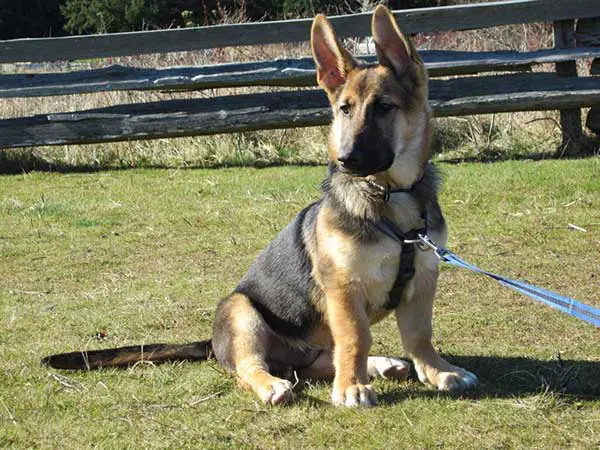 German Shepherd with Dwarfism: Image Source
German Shepherd with Dwarfism: Image Source
Why is dwarfism such a problem when looking for a smaller German shepherd?
Purebred GSDs with dwarfism can look like cuter, smaller versions of their siblings, but it is important to remember that this is a disability from a genetic defect and these dogs should not be deliberately bred to look this way.
If you breed German Shepherds at home and one puppy is accidentally born with the condition, there isn’t too much to be concerned with and they can be raised with their siblings.
The problem comes when buyers think that they are being sold a healthy dog and do not realise the lifelong commitment to healthcare and medical checks.
Dwarf German shepherds are also more likely to have coat problems. Some struggle to regulate their temperature due to a lack of undercoat and others go bald with age.
What sort of cross breeds could you be looking at when buying one of these “mini” GSD pups?
There are a number of small German shepherd breeds out there that are actually a cross between a GSD and a smaller animal.
Many of the dominant genes of the shepherd will come through in the color of the coat or some of the physical characteristics, but there will be other genes from the other animal that are leading to its diminutive stature.
Collies and huskies are commonly bred with these dogs but, in theory, breeders could end up with all kinds of offspring if a GSD bred with a smaller lap dog.
This range of potential breeds may mean that there are lots of interesting looking dogs to choose from, but you could be taking a big gamble. This vast potential for hybridised offspring means that there is a range of interesting looking puppies out there, from miniature white German shepherd to small black German shepherd and so much in-between.
There are lots of cute puppies in need of a good home that will have some GSD genes and some miscellaneous ones – especially if you are buying one that is advertised as a pure breed. The problem in this form of lucky dip is that you may not be sure exactly what you are going to get.
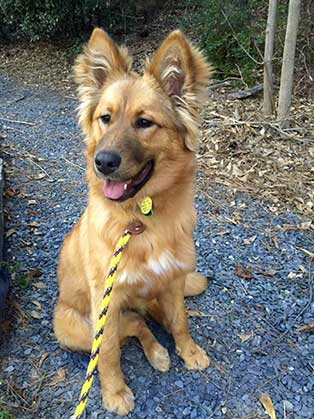 German Shepherd Collie Mix: Source
German Shepherd Collie Mix: Source
How will you know what their temperament and potential health care problems are likely to be?
The biggest concern for unsuspecting buyers is that dealers who are adamant that they are selling these desirable, pure miniature dogs, will not give much away about the true parentage of the animal and any potential implications of that breeding.
Unless you have a clear idea on the genetics of the animal and are 100% clear on the fact that this is a mini German shepherd mix, you could be in for a shock when they grow up.
What sort of personality will your German shepherd miniature have?
This is the biggest concern for anyone looking at a miniature German shepherd for sale.
As was mentioned before, buyers have clear ideas of how a GSD should behave before buying and will assume that their mini version will live up these expectations.
There is always the chance, however, that some of the less desirable, naughty behavioural traits of the other dog will become dominant.
You may expect a loyal, smart family dog that is great with the kids and find that your new puppy is hard to train, hyperactive or doesn’t respond well to children.
Training your mini GSD hybrid
Because the intellect and temperament of your puppy may remain unclear at first, training your new dog could prove to be more of a challenge.
Each breed has its own quirks and there are always little tricks to use to get around problem behaviour, but how do you determine this in an unknown hybrid?
Additionally, you may find that while many GSDs are quick studies with a knack for verbal commands and little need for repetition, your pup may be a little slower and requires a little more patience.
In difficult cases like this, it helps to be able to turn to an online resource such as the Doggy Dan online dog trainer for regular help.
What sort of health care needs will your German shepherd mini have?
German shepherd dogs have a number of potential health care issues to watch out for and the most common concern among owners is joint problems and dysplasia, particularly in the hips.
There is no guarantee that this will be avoided in these small shepherd breeds and there could be additional disease risk and genetic problems coming from the other parent.
Without a clear idea of the parentage and family history, some major problems could creep up on you as the puppy grows up.
What about grooming?
Grooming is something that all GSD owners have to consider because the dense double layers of this big working dog can shed quite a lot, especially during the seasonal moults.
There is the assumption, therefore, that a mini version will have the same requirements, but this may not be the case. Depending on the breed, you may end up with a short haired German shepherd mix that requires less attention, or a fluffy coated breed that requires more attention.
How to buy miniature German shepherd puppies
Now that you know the potential pros and cons of going for one of the “mini” GSD crosses, it is time to decide if you want to get a puppy or not. If the answer is yes, you need to know how to do so responsibly.
If you do decide to buy from a breeder, there is the added issue of the mini German shepherd cost.
Check to see how much the dogs are being sold for and, if the price seems high, why they are going for so much. An expensively-priced animal is not always the best pick if it is sold under false pretences.
The first thing to do is to find a breeder that you can meet in person where you can actually see the puppies that are for sale. See if you can arrange to see the puppies with their parents and the rest of the pups so that you can check to see if they are part of a healthy litter and get to know more about their genetics.
Talk to the breeder about the animals they are selling and see how honest they are willing to be about the parentage, health issues and other considerations when dealing with the pup.
If it is a pure breed, ask why it is so small. If they are honest about it being a hybrid, ask about the likely traits.
Finally, give the puppy a good check to see if there are any clear health problems. This can help you to rule out the dwarfism and runt issues.
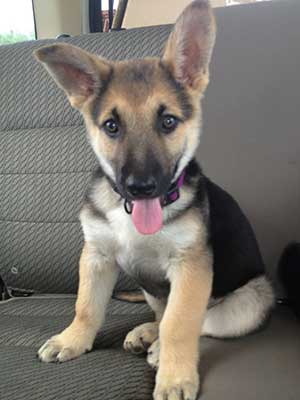 3 Months Old GSD, Runt of the Litter – Source
3 Months Old GSD, Runt of the Litter – Source
A great alternative approach is to consider a miniature German shepherd for adoption
If you are happy to take on a hybrid breed because of their potential temperament and the manageable size, you may want to consider the adoption route rather than going to a miniature German shepherd breeder.
Again, there is the chance that you will not know precisely what their genetic make-up is if the animal has been brought in from a bad home or as a stray, but the shelter staff will be able to tell you all about the character of the dog and what to expect in terms of health care, especially if they are an adult dog.
This approach takes some of the risk factor out of the decision while giving you the chance to do something very noble for an unfortunate animal.
What have we learnt about the mini German shepherd breed?
The main lesson to take away from this guide on small German shepherds is that even though there are three ways that small German Shepherd type dogs can be bred – dwarfism, poor breeding and crossbreeding – you are never going to find that perfect miniature pure bred GSD because it just isn’t possible.
Remember to always take online adverts with a pinch of salt, ignore all those that advertise puppies that sound too good to be true and to look for a breeder that is open and honest about the genetic traits of the puppies that they have for sale.
If the breeder route has put you off, then look into giving an unwanted hybrid small GSD dog a good home.
Do you still think that a mini German Shepherd mix or some kind of small German shepherd dog is right for you?
If you have your heart set on a pure German Shepherd you either have to accept that they are big dogs needing a lot of space or that you will have to opt for a hybrid.
Hopefully the idea of a hybrid dog is a welcome one because it should be about the love, companionship and welfare of the dog rather than trying to find the impossible replication of a GSD in a small breed.
If you decide that you are happy to continue with your search for a small German shepherd breed now you know it is a cross breed, take the time to consider the different issues mentioned here and to find your ideal dog in a responsible way.
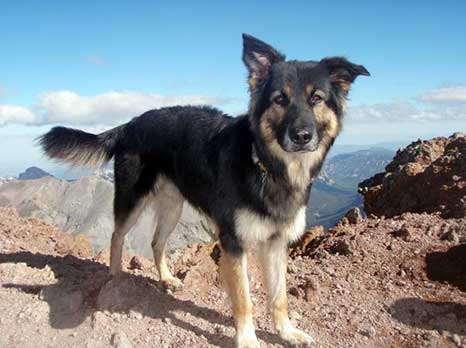 German Shepherd Border Collie Mix: Source
German Shepherd Border Collie Mix: Source
Bypass all of the online adverts and false photographs for those teacup GSDs and search for an honest breeder that will talk to you about the parentage of the dog and what to expect.
You will not be losing out by choosing a hybrid, small German shepherd looking dog over a “real” miniature German Shepherd because they are both the same thing. The only difference is that you will have the peace of mind of knowing precisely what you have bought or adopted, rather than ending up with a dog that is not what as advertised to you at all.

